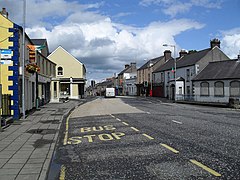Keady
Keady
| |
|---|---|
 Kinelowen Street in the village | |
 Keady Location within Northern Ireland | |
| Population | 3,051 (2011 Census) |
| Irish grid reference | H844340 |
| District | |
| County | |
| Country | Northern Ireland |
| Sovereign state | United Kingdom |
| Post town | ARMAGH |
| Postcode district | BT60 |
| Dialling code | 028 |
| Police | Northern Ireland |
| Fire | Northern Ireland |
| Ambulance | Northern Ireland |
| UK Parliament | |
| NI Assembly | |
Keady (from Irish: An Céide, meaning 'the flat-topped hill'[1]) is a village and civil parish in County Armagh, Northern Ireland. It is south of Armagh and near the border with the Republic of Ireland. It is situated mainly in the historic barony of Armagh with six townlands in the barony of Tiranny.[2] It had a population of 3,051 people in the 2011 Census.[3]
A tributary of the River Callan, known as the Clea, flows from its source in Clea Lake (also spelled as Clay Lake) through the middle of the village. The River Clea once powered Keady's millwheels. In the middle of the village, on the banks of the river, stands the Old Mill, which has been converted into workshops and offices.
History[]
The Troubles[]
For more information see The Troubles in Keady, which includes a list of incidents in Keady during the Troubles resulting in two or more deaths.
Transport[]
- The railway arrived in Keady in 1909, with the opening of the Castleblayney, Keady and Armagh Railway line from Armagh, which was extended to Castleblayney in 1910. Keady railway station opened on 31 May 1909, closed for passenger traffic on 1 February 1932 and finally closed altogether on 1 October 1957.[4] As a cross border line, when the Irish Free State was created in 1922, it lost all passenger traffic in 1923, with freight being withdrawn from the cross border section from Castleblayney to Keady in 1924. The Armagh to Keady freight service was withdrawn on 1 October 1957.
- There is a railway viaduct in Keady as well as one of the more interesting artifacts of Irish railway history, the tunnel for the Ulster and Connaught Light Railway. This was a proposal for a narrow gauge line from Greenore, County Louth to Clifden, County Galway, for which the tunnel under the railway embankment at Keady was built, but never used. Ulsterbus now use part of the tunnel as a bus garage.
Sport[]
This section does not cite any sources. (August 2020) |
Gaelic games have been popular in Keady since the 19th century. The local Gaelic football club, founded in 1888, is Keady Michael Dwyer's GFC. The hurling club, founded in 1949, is Keady Lámh Dhearg; prior to 1949 the Dwyer's club also fielded hurling teams, as did the defunct Éire Óg club in the 1920s and early '30s.
People[]
This section does not cite any sources. (August 2020) |
- Cathal Boylan, Sinn Féin MLA
- Michael Colgan, actor
- Jimmy Jones, footballer
- Tommy Makem, singer, musician, and songwriter
- Sarah Makem (18 October 1900 – 20 April 1983) Traditional Irish singer
- Thomas O'Hanlon, Social Democratic and Labour Party Councillor
- Dessie O'Hare, Irish republican paramilitary
- John Dillon Nugent (1869 – 1 March 1940) Irish nationalist politician
- Louisa Watson Peat (1883–1953) was an Irish-born writer and lecturer.[5][6]
- , : Gaelic life 2019 Ulster Dual Player of the Year, 2020 Side Line Eye Intermediate Team of the Year
- , : Executed Mullingar 1923
Churches in Keady[]
- The Temple Presbyterian, Rev Ian Abraham
- Second Keady Presbyterian, Rev Alan Marsh (www.secondkeady.co.uk)
- St Matthews Church of Ireland
- St Patrick’s Church, Keady, is one of the largest churches in the Archdiocese of Armagh in regard to seating capacity. Built in 1860, it was extended and extensively renovated in 1989.[8]
Schools[]
Demography[]
Keady is classified as an intermediate settlement by the Northern Ireland Statistics and Research Agency (NISRA) (i.e. with a population between 2,500 and 4,999 people).[9] On Census Day (27 March 2011) the usually resident population of Keady Settlement was 3,051, accounting for 0.17% of the NI total.[3] Of these:
- 21.53% were aged under 16 years and 14.00% were aged 65 and over
- 48.90% of the population were male and 51.10% were female
- 87.45% were from a Catholic background and 10.32% were from a 'Protestant and Other Christian (including Christian related)' background
Civil parish of Keady[]
The civil parish contains the villages of Darkley and Keady.[2]
Townlands[]
The civil parish contains the following townlands:[2]
See also[]
References[]
- ^ "Bunachar Logainmneacha na hÉireann".
- ^ Jump up to: a b c "Keady". IreAtlas Townlands Database. Retrieved 7 May 2015.
- ^ Jump up to: a b "Census 2011 Population Statistics for Keady Settlement". Northern Ireland Statistics and Research Agency (NISRA). Retrieved 5 May 2021.
 This article contains quotations from this source, which is available under the Open Government Licence v3.0. © Crown copyright.
This article contains quotations from this source, which is available under the Open Government Licence v3.0. © Crown copyright.
- ^ "Keady station" (PDF). Railscot - Irish Railways. Retrieved 16 October 2007.
- ^ Stanley Kunitz, Marie D. Loizeaux (1952) Wilson Library Bulletin, Vol. 27. p. 682
- ^ Anne Innis Dagg (2001) The Feminine Gaze: A Canadian Compendium of Non-Fiction Women Authors and Their Books, 1836-1945. p. 236-237
- ^ https://www.betterworldbooks.com/product/detail/burke-grealy-mullingar-s-two-forgotten-martyrs-1986648087 Stanley Kunitz, Marie D. Loizeaux (1952) Wilson Library Bulletin, Vol. 27. p. 682
- ^ "Welcome Statement". Parish of Keady, Derrynoose & Madden. Retrieved 2 June 2021.
- ^ "Review of the Statistical Classification and Delineation of Settlements" (PDF). Northern Ireland Statistics and Research Agency (NISRA). March 2015. Archived (PDF) from the original on 7 June 2018. Retrieved 5 May 2021.
External links[]
| Wikimedia Commons has media related to Keady. |
- Villages in County Armagh
- Civil parish of Keady


